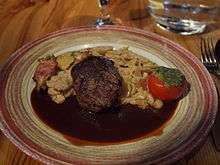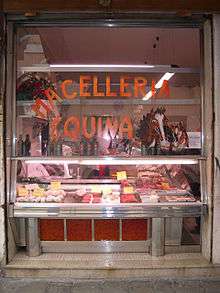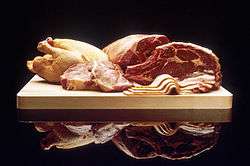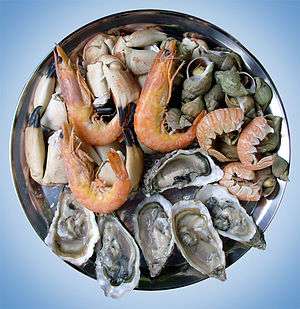Horse meat

Horse meat (or horse beef) is the culinary name for meat cut from a horse. It is a major meat in only a few countries, notably in Central Asia, but it forms a significant part of the culinary traditions of many others, from Europe to South America to Asia. The top eight countries consume about 4.7 million horses a year. For the majority of humanity's early existence, wild horses were hunted as a source of protein.[1][2] It is slightly sweet, tender and low in fat.
Because of the role horses have played as companions and as workers, and ensuing concerns about the ethics of the horse slaughter process, it is a taboo food in some cultures, for example the Romani, whose culture contains a rich history of equine husbandry. These historical associations, as well as ritual and religion, led to the development of an aversion to the consumption of horse meat in some cultures. The horse is now given pet status by many in some parts of the Western world, particularly in the United States, United Kingdom, and Ireland, which further solidifies the taboo on eating its meat.
History
In the Paleolithic, wild horses formed an important source of food. In many parts of Europe, the consumption of horse meat continued throughout the Middle Ages until modern times, despite a papal ban of horse meat in 732.[3] Horse meat was also eaten as part of Germanic pagan religious ceremonies in northern Europe, particularly ceremonies associated with the worship of Odin.
Horses originally developed on the North American Continent, and about 15,000 years ago migrated to other parts of the world. The largest fossil beds of horses is in Idaho at the Hagerman Fossil Beds, a national monument. The horses were about the size of a modern-day Arabian horse. The Europeans' horses that came over to the Americas with the Spaniards and followed by the settlers became feral, and were hunted by the indigenous Pehuenche people of what is now Chile and Argentina.[4] At first, they hunted horses as they did other game, but later they began to raise them for meat and transport. The meat was, and still is, preserved by being sun-dried in the high Andes into a product known as charqui.
France dates its taste for horse meat to the Revolution. With the fall of the aristocracy, its auxiliaries had to find new means of subsistence. Just as hairdressers and tailors set themselves up to serve commoners, the horses maintained by aristocracy as a sign of prestige ended up alleviating the hunger of lower classes.[5] During the Napoleonic campaigns, the surgeon-in-chief of Napoleon's Grand Army, Baron Dominique-Jean Larrey, advised the starving troops to eat the meat of horses. At the siege of Alexandria, the meat of young Arab horses relieved an epidemic of scurvy. At the battle of Eylau in 1807, Larrey served horse as soup and bœuf à la mode. At Aspern-Essling (1809), cut off from the supply lines, the cavalry used the breastplates of fallen cuirassiers as cooking pans and gunpowder as seasoning, and thus founded a tradition that carried on until at least the Waterloo campaign.[6][7]
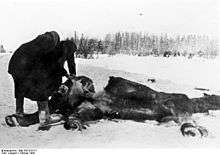
Horse meat gained widespread acceptance in French cuisine during the later years of the Second French Empire. The high cost of living in Paris prevented many working-class citizens from buying meat such as pork or beef, so in 1866, the French government legalized the eating of horse meat and the first butcher's shop specializing in horse meat opened in eastern Paris, providing quality meat at lower prices.[8] During the Siege of Paris (1870–1871), horse meat was eaten by anyone who could afford it, partly because of a shortage of fresh meat in the blockaded city, and also because horses were eating grain which was needed by the human populace. Many Parisians gained a taste for horse meat during the siege, and after the war ended, horse meat remained popular. Likewise, in other places and times of siege or starvation, horses are viewed as a food source of last resort.
Despite the general Anglophone taboo, horse and donkey meat was eaten in Britain, especially in Yorkshire, until the 1930s,[9] and in times of postwar food shortage surged in popularity in the United States[10] and was considered for use in hospitals.[11] A 2007 Time magazine article about horse meat brought in from Canada to the United States characterized the meat as sweet, rich, superlean, oddly soft meat, and closer to beef than venison.[12]
Taboo
Attitude of various cultures
Horse is commonly eaten in many countries in Europe and Asia.[13][14][15] It is not a generally available food in some English-speaking countries such as the United Kingdom, Australia, Ireland, the United States,[16] and English Canada. It is also taboo in Brazil, Israel, and among the Romani people and Jewish people the world over. Horse meat is not generally eaten in Spain, except in the north, although the country exports horses both live animals and slaughtered meat for the French and Italian markets. Horse meat is consumed in some North American and Latin American countries, and is illegal in some countries. For example, the Food Standards Code of Australia and New Zealand definition of 'meat' does not include horse.[17] In Tonga, horse meat is eaten nationally, and Tongan emigrees living in the United States, New Zealand, and Australia have retained the taste for it, claiming Christian missionaries originally introduced it to them.[18]
In Islamic laws, consuming horse meat is makruh or discouraged, although it is not haram or forbidden. The consumption of horse meat has been common in Central Asia societies, past or present, due to the abundance of steppes suitable for raising horses. In North Africa, horse meat has been occasionally consumed, but almost exclusively by the Christian Copts and the Hanafi Sunnis (a common form of Islam in Central Asia and Turkey), but has never been eaten in the Maghreb.[19]
Horse meat is forbidden by Jewish dietary laws because horses do not have cloven hooves and they are not ruminants.
In the eighth century, Popes Gregory III and Zachary instructed Saint Boniface, missionary to the Germans, to forbid the eating of horse meat to those he converted, due to its association with Germanic pagan ceremonies.[20][21] The people of Iceland allegedly expressed reluctance to embrace Christianity for some time, largely over the issue of giving up horse meat.[22] Horse meat is now currently consumed in Iceland and many horses are raised for this purpose. The culturally close people of Sweden still have an ambivalent attitude to horse meat, said to stem from this time.
Henry Mayhew describes the difference in the acceptability and use of the horse carcass in London and Paris in London Labour and the London Poor (1851).[23] Horse meat was rejected by the British, but continued to be eaten in other European countries such as France and Germany, where knackers often sold horse carcasses despite the papal ban. Even the hunting of wild horses for meat continued in the area of Westphalia. Londoners also suspected that horse meat was finding its way into sausages, and that offal sold as that of oxen was in fact equine. About 1,000 horses were slaughtered a week.
While no taboo on eating horse meat exists per se, it is generally considered by ethnic Russians to be a low-quality meat with poor taste, and it is rarely found in stores.
It is popular among such peoples as Tatars, Yakuts, Kyrgyzs, and Kazakhs.[24]
Reasons for the taboo
In 732 AD, Pope Gregory III began a concerted effort to stop the ritual consumption of horse meat in pagan practice. In some countries, the effects of this prohibition by the Roman Catholic Church have lingered and horse meat prejudices have progressed from taboos, to avoidance, to abhorrence.[22] In other parts of the world, horse meat has the stigma of being something poor people eat and is seen as a cheap substitute for other meats, such as pork and beef.
According to the anthropologist Marvin Harris,[5] some cultures class horse meat as taboo because the horse converts grass into meat less efficiently than ruminants.
Totemistic taboo is also a possible reason for refusal to eat horse meat as an everyday food, but did not necessarily preclude ritual slaughter and consumption. Roman sources state that the goddess Epona was widely worshipped in Gaul and southern Britain. Epona, a triple aspect goddess, was the protectress of the horse and horse keepers, and horses were sacrificed to her;[25] she was paralleled by the Irish Macha and Welsh Rhiannon. In The White Goddess, Robert Graves argued that the taboo among Britons and their descendants was due to worship of Epona, and even earlier rites.[26] The Uffington White Horse is probable evidence of ancient horse worship. The ancient Indian Kshatriyas engaged in horse sacrifice (Ashwamedh Yaghya) as recorded in the Vedas and Ramayana; but within context of the ritual sacrificial is not being 'killed' but instead being smothered to death.[27] In 1913, the Finnic Mari people of the Volga region were observed to practice a horse sacrifice.[27]
In ancient Scandinavia, the horse was very important, as a living, working creature, as a sign of the owner's status, and symbolically within the old Norse religion. Horses were slaughtered as a sacrifice to the gods and the meat was eaten by the people taking part in the religious feasts.[28] When the Nordic countries were Christianized, eating horse meat was regarded as a sign of paganism and prohibited. A reluctance to eat horse meat is still common in these countries even today.[29]
Production
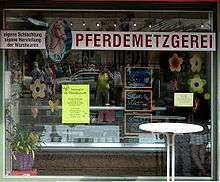
In most countries where horses are slaughtered for food, they are processed in a similar fashion to cattle, i.e., in large-scale factory slaughter houses (abattoirs) where they are stunned with a captive bolt gun and bled to death. In countries with a less industrialized food production system, horses and other animals are slaughtered individually outdoors as needed, in the village where they will be consumed, or near to it.[30]
In 2005, the eight principal horse meat-producing countries produced over 700,000 tonnes of this product.
Major Horse meat Production Countries, 2005[31] Country Production number of animals tonnes short tons long tons USA 1,700,000 204,000 225,000 201,000 Mexico 626,000 78,876 86,946 77,630 Kazakhstan 340,000 55,100 60,700 54,200 Mongolia 310,000 38,000 42,000 37,000 Argentina 255,000 55,600 61,300 54,700 Italy 213,000 48,000 53,000 47,000 Brazil 162,000 21,200 23,400 20,900 Kyrgyzstan 150,000 25,000 28,000 25,000 Worldwide
Totals4,727,829 720,168 793,849 708,794
In 2005, the five biggest horse meat-consuming countries were China (421,000 tonnes), Mexico, Russia, Italy, and Kazakhstan (54,000 tonnes).[32] In 2010, Mexico produced 140,000 tonnes, China - 126,000 tonnes, Kazakhstan - 114,000 tonnes.
As horses are relatively poor converters of grass and grain to meat compared to cattle,[5] they are not usually bred or raised specifically for their meat. Instead, horses are slaughtered when their monetary value as riding or work animals is low, but their owners can still make money selling them for horse meat, for example in the routine export of the southern English ponies from the New Forest, Exmoor, and Dartmoor.[33][34] British law requires the use of "equine passports" even for semiwild horses to enable traceability (also known as "provenance"), so most slaughtering is done in the UK before the meat is exported,[34] meaning that the animals travel as carcasses rather than live. Ex-racehorses, riding horses, and other horses sold at auction may also enter the food chain; sometimes these animals have been stolen or purchased under false pretenses.[35] Even prestigious horses may end up in the slaughterhouse; the 1986 Kentucky Derby winner and 1987 Eclipse Award for Horse of the Year winner, Ferdinand, is believed to have been slaughtered in Japan, probably for pet food.[36]
A misconception exists that horses are commonly slaughtered for pet food, however. In many countries, like the United States, horse meat was outlawed in pet food in the 1970s. American horse meat is considered a delicacy in Europe and Japan, and its cost is in line with veal,[37] so it would be prohibitively expensive in many countries for pet food.[38]
The British newspaper The Daily Mail reports that every year, 100,000 live horses are transported into and around the European Union for human consumption, mainly to Italy, but also to France and Belgium.[39]
Meat from horses that veterinarians have put down with a lethal injection is not suitable for human consumption, as the toxin remains in the meat; the carcasses of such animals are sometimes cremated (most other means of disposal are problematic, due to the toxin). Remains of euthanized animals can be rendered, which maintains the value of the skin, bones, fats, etc., for such purposes as fish food. This is commonly done for lab specimens (e.g., pigs) euthanized by injection. The amount of drug (e.g. a barbiturate) is insignificant after rendering.
Carcasses of horses treated with some drugs are considered edible in some jurisdictions. For example, according to Canadian regulation, hyaluron, used in treatment of particular disorders in horses, in HY-50 preparation, should not be administered to animals to be slaughtered for horse meat.[40] In Europe, however, the same preparation is not considered to have any such effect, and edibility of the horse meat is not affected.[41]
Opposition to production
The killing of horses for human consumption is widely opposed in countries such as the U.S.,[42][43] UK[44] and Australia.[45] where horses are generally considered to be companion and sporting animals only.[46] Almost all equine medications and treatments are labeled as being not intended for human consumption. In the European Union, horses intended for slaughter cannot be treated with many medications commonly used for U.S. horses. For horses going to slaughter, no period of withdrawal, the time between administration of the drug and the time they are butchered, is required. French actress and animal rights activist Brigitte Bardot has spent years crusading against the eating of horse meat. However, the opposition is far from unanimous; a 2007 readers' poll in the London magazine Time Out showed that 82% of respondents supported chef Gordon Ramsay's decision to serve horse meat in his restaurants.[47]
Nutritional value
| Food source | Energy | Protein (g) |
Fat (g) |
Iron (mg) |
Sodium (mg) |
Cholesterol (mg) | |
|---|---|---|---|---|---|---|---|
| (kJ) | (Cal) | ||||||
| Game meat, horse, raw | 560 | 133 | 21 | 5 | 3.8 | 53 | 52 |
| Beef, strip steak, raw | 490 | 117 | 23 | 3 | 1.9 | 55 | 55 |
Preparation
Horse meat has a slightly sweet taste reminiscent of a combination of beef and venison. Meat from younger horses tends to be lighter in color, while older horses produce richer color and flavor, as with most mammals. Horse meat can be used to replace beef, pork, mutton, venison, and any other meat in virtually any recipe. Horse meat is usually very lean. Jurisdictions which allow for the slaughter of horses for food rarely have age restrictions, so many are quite old. Those preparing sandwiches or cold meals with horse meat usually use it smoked and salted. It forms an ingredient in several traditional recipes of salami.
Horse meat in various countries
In 2009, a British agriculture industry website reported these horse meat production levels in various countries:
| Country | Tons per year |
|---|---|
| Mexico | 78,000 |
| Argentina | 57,000 |
| Kazakhstan | 55,000 |
| Mongolia | 38,000 |
| Kyrgyzstan | 25,000 |
| Australia | 24,000 |
| Brazil | 21,000 |
| Canada | 18,000 |
| Poland | 18,000 |
| Italy | 16,000* |
| Romania | 14,000 |
| Chile | 10,000 |
| France | 7,500 |
| Uruguay | 8,000 |
| Senegal | 9,500 |
| Colombia | 6,000 |
| Spain | 5,000* |
- *Including donkeys.
Asia-Pacific
Australia
Australians do not generally eat horse meat, although they have a horse slaughter industry that exports to Japan, Europe, and Russia.[52] Horse meat exports peaked at 9,327 tons 1986, declining to 3,000 tons in 2003. The two abattoirs in Australia licensed to export horse meat are Belgian-owned. They are at Peterborough in South Australia (Metro Velda Pty Ltd) and Caboolture Abattoir in Queensland (Meramist Pty Ltd).[53] A British agriculture industry website reported that Australian horse meat production levels had risen to 24,000 tons by 2009.[51]
On 30 June 2010, Western Australian Agriculture Minister Terry Redman granted final approval to Western Australia butcher Vince Garreffa to sell horse meat for human consumption. Nedlands restaurateur Pierre Ichallalene announced plans to do a taster on Bastille Day and to put horse meat dishes on the menu if the reaction is good. Mr. Redman said that the government would "consider extending approvals should the public appetite for horse demand it".[54]
Mr. Garreffa is the owner of Mondo Di Carne, a major wholesale meat supplier which supplies many cafes, restaurants, and hotels in Western Australia.[55][56] He commented that no domestic market exists for horse meat, but a successful export market exists, of which he believes Western Australia should have a share.[54]
This decision caused outrage amongst some groups, limited reaction from many, and enthusiasm from others. Several local newspaper forums indicated that the general public were not greatly biased either way, in fact many voiced their openness for alternative meats.
Horse meat consumption has continued as a niche market in Australia, with further potential for growth as gourmet interests develop.
China
Although it is generally acceptable to Chinese people, outside of specific areas such as Guilin in Guangxi or in Yunnan Province, horse meat is not popular due to its low availability and rumors that horse meat tastes bad or it is bad for health. Because the Compendium of Materia Medica written in Ming dynasty by Li Shizhen indicates that horse meat is poisonous and may cause folliculitis or death.[57] The Compendium of Materia Medica also asserts, "To relieve toxin caused by eating horse meat, one can drink Phragmites root jouce and eat apricot kernel." Today, in southern China, locally famous dishes include horse meat rice noodles (马肉米粉; Pinyin: mǎròu mǐfěn) in Guilin and horce meat hot pot(马肉火锅; Pinyin: mǎròu huǒguō) in Huishui County in Guizhou Province. In the northwest, Kazakh people eat horse meat.
Indonesia
In Indonesia, one type of satay (chunks of skewered grilled meat served with spicy sauce) known as horse satay (Javanese:sate jaran, Indonesian:sate kuda) is made from horse meat. This delicacy from Yogyakarta is served with sliced fresh shallot, pepper, and sweet soy sauce.[58]
Japan

In Japanese cuisine, raw horse meat is called sakura (桜?) or sakuraniku (桜肉?, sakura means cherry blossom, niku means meat) because of its pink color. It can be served raw as sashimi in thin slices dipped in soy sauce, often with ginger and onions added.[59] In this case, it is called basashi (馬刺し). Basashi is popular in some regions of Japan and is often served at izakaya bars. Fat, typically from the neck, is also found as basashi, though it is white, not pink. Horse meat is also sometimes found on menus for yakiniku (a type of barbecue), where it is called baniku (馬肉, literally "horse meat") or bagushi (馬串, "skewered horse"); thin slices of raw horse meat are sometimes served wrapped in a shiso leaf. Kumamoto, Nagano, and Ōita are famous for basashi, and it is common in the Tohoku region, as well. Some types of canned "corned meat" in Japan include horse as one of the ingredients.[60][61]
Aside raising local draft horses for meat,[62][63] Japan imports living horses (from Canada) and meat from several countries - five largest are Canada, Mexico, Italy, Argentina and Brazil.[64]
Kazakhstan and Kyrgyzstan
In Kazakhstan and Kyrgyzstan, horse meat is a large part of the diet, due mainly to the nomadic roots of the population.[65] Some of the dishes include sausages called kazy and chuchuk or shuzhyk made from the meat using the guts as the sausage skin, zhaya made from hip meat which is smoked and boiled, jal made from neck fat which is smoked and boiled, karta made from a section of the rectum which is smoked and boiled, and sur-et which is kept as dried meat.[66]
Mongolia
Mongols prefer beef and mutton over horse meat.[67] Salted horse meat sausages called kazy are produced as a regional delicacy by the Kazakhs Mongols prefer beef and mutton, though during the extremely cold Mongolian winter, some people prefer horse meat due to its low cholesterol. It is kept unfrozen, and traditionally people think horse meat helps warm them up.[68]
Other Asian nations import processed horse meat from Mongolia.[64][69][70]
Philippines
In the Philippines, horse meat (lukba, tapang kabayo, or kabayo) is a delicacy commonly sold in wet markets. The method of preparation is very common which includes marinating the meat in calamansi or lemon juice, toyo (soy sauce), and patís (fish sauce). It is then fried and served, and often dipped into vinegar to give the meat a tart flavour.
South Korea
In South Korea, horse meat is generally not eaten, but raw horse meat, usually around the neck part, is consumed as a delicacy on Jeju Island. It is usually seasoned with soy sauce and sesame oil.[71][72]
Tonga
In Tonga, horsemeat or lo'i ho'osi is much more than just a delicacy; the consumption of horsemeat is generally only reserved for special occasions. These special occasions may include the death of an important family member or community member or as a form of celebration during the birthday of an important family member or perhaps the visitation of someone important, such as the King of Tonga.
In Tonga, a horse is one of the most valuable animals a family can own because of its use as a beast of burden. Therefore, the slaughter of one's horse for consumption becomes a moment of immense homage to the person or event for which the horse was slain. Despite a diaspora into Western countries such as Australia, the USA, and New Zealand, where consumption of horsemeat is generally taboo, Tongans still practice the consumption of horse meat perhaps even more so because it is more readily available and more affordable.
Europe
In 2013, horse meat and traces of horse DNA were found in some food products where horse was not labelled as an ingredient, sparking the 2013 meat adulteration scandal across Europe.
Austria
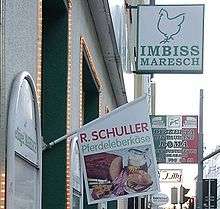
Horse Leberkäse is available in special horse butcheries and occasionally at various stands, sold in a bread roll. Dumplings can also be prepared with horse meat, spinach, or Tyrolean Graukäse (a sour milk cheese). They are occasionally eaten on their own, in a soup, or as a side dish.
Belgium
In Belgium, horse meat (paardenvlees in Dutch and viande chevaline in French) is popular in a number of preparations. Lean, smoked, and sliced horse meat fillet (paardenrookvlees or paardengerookt; filet chevalin in French) is served as a cold cut with sandwiches or as part of a cold salad. Horse steaks can be found in most butchers and are used in a variety of preparations. The city of Vilvoorde has a few restaurants specialising in dishes prepared with horse meat. Horse sausage is a well-known local specialty in Lokeren with European recognition.[73] Smoked or dried horse/pork meat sausage, similar to salami, is sold in a square shape to be distinguished from pork and/or beef sausages.[74][75] A Flemish region around the Rupel river is also famous for a horse stew named 'Schep', made out of shoulder chuck (or similar cuts), brown ale, onions and mustard. Schep is typically served with French fries, mayonnaise and a salad of raw Belgian endive.
Bulgaria
Horse meat is served in some restaurants in Bulgaria, as the preferred way of consuming it is in the form of steaks and burgers. Still being far from a meat for mass consumption, horse beef is re-gaining its popularity, which it had in the 60s and 70s of the past century, when it was also consumed in in sausages and tartares.
France


In France, specialized butcher shops (boucheries chevalines) sell horse meat, as ordinary butcher shops were for a long time forbidden to deal in it. However, since the 1990s, it can be found in supermarket butcher shops and others.
Horse meat was famously eaten in large amounts during the 1870 Siege of Paris, when it was included in haute cuisine menus.
Germany
In Germany horse meat is sold by specialized butchers (Pferdemetzgereien) and by mail order. Many regions of Germany have traditional recipes that include horse meat. In the Rhineland around Cologne and Düsseldorf it is still common for restaurants to offer the traditional Sauerbraten in horse meat and beef variants. Other traditional horse meat dishes include the Swabian Pferderostbraten (a joint of roast meat prepared similarly to roast beef), Bavarian sausage varieties such as Rosswurst and Ross-Kochsalami as well as Ross-Leberkäse, a meatloaf dish.
The 2013 meat adulteration scandal started when German authorities detected horse meat in prepared food products including frozen lasagna, where it was declared fraudulently as beef. The mislabeling prompted EU authorities to speed up publication of European Commission recommendations for labeling the origin of all processed meat.[76]
Hungary
In Hungary, horse meat is primarily used in salami and sausages, usually mixed with pork, but also in goulashes and other stews. These products are sold in most supermarkets and many butcher shops.
Iceland
In Iceland, it is both eaten minced and as steak, also used in stews and fondue, prized for its strong flavor. It has a particular role in the culture and history of the island. The people of Iceland supposedly were reluctant to embrace Christianity for some time largely over the issue of giving up horse meat after Pope Gregory III banned horse meat consumption in 732 AD, as it was a major part of many pagan rites and sacrifice in Northern Europe. Horse meat consumption was banned when the pagan Norse Icelanders eventually adopted Christianity in the year 1000. The ban became so ingrained that most people would not handle horse meat let alone consume it. Even during harsh famines in the 18th Century most people would not eat horse meat, and those who did were castigated. In 1757 the ban was decriminalised, but general distaste for horse meat lasted well into the 19th Century, possibly longer and its consumption often regarded as an indication of poverty. Even today horse meat is not popular (3.2% of Iceland’s meat production in 2015), although this has more to do with culinary tradition and the popularity of equestrianism than any religious vestiges.
Italy
Horse meat is especially popular in Lombardia, Veneto, Friuli-Venezia Giulia, Trentino-Alto Adige/Südtirol, Parma, Apulia, and the islands of Sardinia and Sicily.
Horse meat is used in a variety of recipes: as a stew called pastissada (typical of Verona), served as steaks, as carpaccio, or made into bresaola. Thin strips of horse meat called sfilacci are popular . Horse fat is used in recipes such as pezzetti di cavallo. Horse meat sausages and salamis are traditional in various places . In Sardinia, sa petza 'e cuaddu or sa petha (d)e caddu (campidanese and logudorese for horse meat) is one of the most renowned meats and sometimes is sold in typical kiosks with bread - also in the town of Sassari is a long tradition of eating horse steaks (carri di cabaddu in the local dialect). Chefs and consumers tend to prize its uniqueness by serving it as rare as possible. Donkey is also cooked, for example as a stew called stracotto d'asino and as meat for sausages e.g. mortadella d'asino . The cuisine of Parma features a horsemeat tartare called pesto di cavallo, as well as various cooked dishes.[77][78]
In Veneto, the consumption of horse meat dates back to at least 1000 BC to the Adriatic Veneti, renowned for their horse-breeding skills. They were used to sacrifice horses to their goddess Reitia or to the mythical hero Diomedes.[79][80] Throughout the classical period, Veneto established itself as a centre for horse breeding in Italy; Venetian horses were provided for the cavalry and carriage of the Roman legions, with the white Venetic horses becoming famous among Greeks and Romans as one of the best breeds for circus racing.[81] As well as breeding horses for military and farming applications, the Venetics also used them for consumption throughout the Roman period, a practice that established the consumption of horse meat as a tradition in Venetian cuisine. In the modern age, horse meat is considered a luxury item and is widely available through supermarkets and butcheries, with some specialised butcheries offering only selected cuts of equine meat. Prices are usually higher than beef, pork, or any other kind of meat, except game.
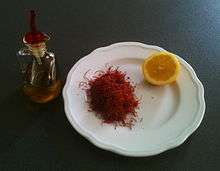
In the Province of Padua, horse meat is a key element of the local cuisine, particularly in the area that extends southeast from the city, historically called Saccisica.[82] Specialties based on horse meat constitute the main courses and best attractions of several typical restaurants in the zone. They are also served among other regional delicacies at the food stands of many local festivals, related to civil and religious anniversaries. Most notable is the Festa del Cavallo, held annually in the small town of Legnaro and totally dedicated to horses, included their consumption for food.
Some traditional dishes are:
- Sfilacci di cavallo: tiny frayings of horse meat, dried and seasoned; to be consumed raw, can be a light and quick snack, more popular as a topping on other dishes: ex. pasta, risotto, pizza, salads, etc.
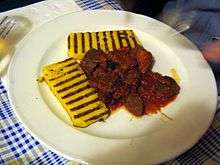 Cavàeo in Umido (traditional horsemeat stew from Padua) with grilled polenta
Cavàeo in Umido (traditional horsemeat stew from Padua) with grilled polenta - Straéca: a thin soft horse steak, cut from the diaphragm, variously cooked and dressed on the grill, pan or hot-plate
- Bistecca di puledro colt steak, whose preparation is similar to straéca
- Spezzatino di cavallo also said cavàeo in umido, small chunks of horse meat, stewed with onion, parsley and/or other herbs and flavours, potatoes, broth, wine, etc., usually consumed with polenta, much appreciated also is a similar stew made of donkey meat, served in traditional trattorie, with many variations for different villages: spessadin de musso, musso in umido, musso in tocio, musso in pocio
- Prosciutto di cavallo: horse ham, served in very thin slices
- Salame di cavallo or salsiccia di cavallo: various kinds of salami, variously produced or seasoned, sometimes made of pure equine meat, sometimes mixed with others (beef or pork)
- Bigoli al sugo di cavallo: a typical form of fresh pasta, similar to thick rough spaghetti, dressed with sauce like Bolognese sauce, but made with minced horse meat
- Pezzetti di cavallo al sugo: horse stew, seasoned with sauce, vegetables and various peperocino, widely used in the Salento
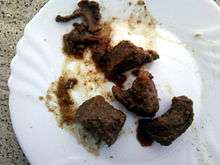 Chunks (pezzetti) of horse stew (spezzatino di cavallo)
Chunks (pezzetti) of horse stew (spezzatino di cavallo)
In southern Italy, horse meat is commonly eaten everywhere - especially in the region of Apulia, where it is considered a delicacy.[83][84] It is often a vital part of the ragù barese ([raˈɡu baˈreːze]) in Bari.[85]
According to British food writer Matthew Fort, "The taste for donkey and horse goes back to the days when these animals were part of everyday agricultural life. In the frugal, unsentimental manner of agricultural communities, all the animals were looked on as a source of protein. Waste was not an option."[86]
Malta
In Malta, horse meat (Maltese: Laħam taż-żiemel) is seared and slowly cooked for hours in either tomato or red wine sauce. A few horse meat shops still exist and it is still served in some restaurants.[87]
Netherlands
In the Netherlands, smoked horse meat (paardenrookvlees) is sold as sliced meat and eaten on bread. Zuurvlees, a southern Dutch stew, is made with horse meat as main ingredient. There are also beef-based variants. Horse meat is also used in sausages (paardenworst and frikandel),[88] fried fast food snacks and ready-to-eat soups.[89][90]
Norway
In Norway, horse meat is commonly used in cured meats, such as vossakorv and svartpølse, and less commonly as steak, hestebiff.
In pre-Christian Norway, horse was seen as an expensive animal. To eat a horse was to show one had great wealth, and to sacrifice a horse to the gods was seen as the greatest gift one could give. When Norwegians adopted Christianity, horse-eating became taboo as it was a religious act for pagans, thus it was considered a sign of heresy.[91]
Poland
Live, old horses are often exported to Italy to be slaughtered. This practice also garners controversy. Horses in Poland are treated mostly as companions and the majority of society is against the live export to Italy. However, in Poland there exists a tradition of eating horse meat (sausage or tartare steaks). The consumption of horse meat was the biggest in the times when other meat was scarce (in the 20th century: WWII and the communist period).
Serbia
Horse meat is generally available in Serbia, though mostly shunned in traditional cuisine. It is, however, often recommended by general practitioners to persons who suffer from anemia. It is available to buy at three green markets in Belgrade, a market in Niš, and in several cities in ethnically mixed Vojvodina, where Hungarian and previously German traditions brought the usage.
Slovenia

Horse meat is generally available in Slovenia, and is highly popular in the traditional cuisine, especially in the central region of Carniola and in the Karst region. Colt steak (žrebičkov zrezek) is also highly popular, especially in Slovenia's capital Ljubljana, where it is part of the city's traditional regional cuisine. In Ljubljana, many restaurants sell burgers and meat that contain large amounts of horse meat, including a fast-food chain called Hot Horse.[92][93]
Spain
Cecina is cured meat made from beef or horse, and it is considered as a delicacy. Foal meat (carne de potro) is preferred rather than horse meat, and it is easy to find in supermarkets and usually prepared as stew or steak. It is a common practice to give it to children with anemia. Although no generalized taboo exists, its consumption is minor compared to pork, beef, and lamb.
Sweden
Smoked/cured horse meat is widely available as a cold cut under the name hamburgerkött (hamburger meat). It tends to be very thinly sliced and fairly salty, slightly reminiscent of deli-style ham. Gustafskorv, a smoked sausage made from horse meat, is also quite popular, especially in the province of Dalarna, where it is made. It is similar to salami or metworst and is used as an alternative to them on sandwiches. It is also possible to order horse beef from some well-stocked grocery stores.
Switzerland
The ordinance on foodstuffs of animal origin in Switzerland explicitly lists equines as an animal species allowed for the production of food.[94] Horse steak is modestly common. A speciality known as Mostbröckli is made with beef or horse meat. It is also used for a range of sausages in the German-speaking north of Switzerland. Like in northern Italy, in the Italian-speaking south, local salametti (sausages) are sometimes made with horse meat. It may also be used in fondue Bourguignonne.
United Kingdom
In the United Kingdom, the slaughter, preparation, and consumption of horses for food is not against the law, although it has been rare since the 1930s and it is not generally available. There is a cultural taboo against consuming horse meat in the UK, although it was eaten when other meats were scarce, such as during times of war[95][96] (as was whale meat, which was never popular in Britain). The sale of meat labelled as horse meat in supermarkets and butchers is minimal, and most of the properly described horse meat consumed in the UK is imported from Europe, predominantly the south of France, where it is more widely available.[97]
Horse meat may be eaten without the knowledge of the consumer, due to accidental or fraudulent introduction of horse meat into human food. A 2003 Food Standards Agency (FSA) investigation revealed that salami and similar products such as chorizo and pastrami sometimes contain horse meat without it being listed,[98] although listing is legally required.[99]
Horse meat was featured in a segment in a 2007 episode of the Gordon Ramsay series The F Word. In the segment, Janet Street-Porter convinced locals to try horse meat, though not before facing controversy and being forced to move her stand to a privately-owned location. The meat was presented as having a similar taste to beef, but with less fat, a high concentration of omega-3 fatty acid and a safer alternative in times of worry regarding bird flu and mad cow disease. The segment was met with skepticism from many after broadcast for various reasons, either because some felt the practice was cruel and against social norms, or simply a belief that if the taste was really on par with other meats, then people would already be eating it.[100]
Ukraine
In Ukraine, especially in Crimea and other southern steppe regions, horse meat is consumed in the form of sausages called mahan and sudzhuk. These particular sausages are traditional food of the Crimean Tatar population.
North America
Canada
A thriving horse meat business exists in Quebec; the meat is available in most supermarket chains there.[101] Horse meat is also for sale at the other end of the country, in Granville Island Market in downtown Vancouver, where according to a Time magazine reviewer who smuggled it into the United States, it turned out to be a "sweet, rich, superlean, oddly soft meat, closer to beef than venison".[12] Horse meat is also available in high-end Toronto butchers and supermarkets. Aside from the heritage of French cuisine at one end of the country, the majority of Canada shares the horse meat taboo with the rest of the Anglosphere. This mentality is especially evident in Alberta, where strong horse racing and breeding industries and cultures have existed since the province's founding, although large numbers of horses are slaughtered for meat in Fort MacLeod,[102] and certain butchers in Calgary do sell it.
The consumer protection show Kassensturz of Swiss television SRF together with Tier Schutz Bund, Zürich, reported on 19 February 2013 the bad treatment and brutal animal husbandry in Canadian horse meat farms in Fort MacLeod, Alberta,[103][104] consequently the import from such farms has been boycotted.[105]
CBC News reported on March 10, 2013, that horse meat was also popular among some segments of Toronto's population. [106]
United States
Horse meat is generally not eaten in the United States and holds a taboo in American culture which is very similar to the one found in the United Kingdom.[107] All horse meat produced in the United States (up until the last quarter of 2007) was intended solely for export abroad, primarily to the European Union. A thriving horse exportation business is going on in several states, including Texas, mainly exporting horses to slaughterhouses in either Canada or Mexico.[108]
Restriction of human consumption of horse meat in the U.S. has generally involved legislation at local, state, and federal levels. Several states enacted legislation either prohibiting the sale of horse meat or banning altogether the slaughter of horses. California Proposition 6 (1998) was passed by state voters, outlawing the possession, transfer, reception, or holding any horse, pony, burro, or mule by a person who is aware that it will be used for human consumption, and making the slaughter of horses or the sale of horsemeat for human consumption a misdemeanor offense.[109]
In 2007, the Illinois General Assembly enacted Public Act 95-02, ameding Chapter 225, Section 635 of the state's compiled statutes [110] to prohibit both the act of slaughtering equines for human consumption as well as the trade of any horse meat similarly to Texas Agriculture Code's Chapter 149.
Other states banning horse slaughter or the sale of horse meat include New Jersey, Oklahoma, and Mississippi. In addition, several other states introduced legislation to outlaw the practice over the years, such as Florida, Massachusetts, New Mexico, and New York.
At federal level, since 2001 several bills have been regularly introduced in both the House and Senate to ban horse slaughter throughout the country without success. However, a budgetary provision banning the use of federal funds to carry out mandatory inspections at horse slaughter plants (necessary to allow interstate sale and exports of horse meat) has been also in place since 2007. Such restriction was temporarily removed in 2011 as part of the Consolidated and Further Continuing Appropriations Act for Fiscal Year 2012 [111] but was again included in the FY2014 Agriculture Appropriations Act and subsequent federal budgets, hence preventing the operation of any domestic horse slaughter operation.
Until 2007, only three horse meat slaughterhouses still existed in the United States for export to foreign markets, but they were closed by court orders resulting from the upholding of aforementioned Illinois and Texas statutes banning horse slaughter and the sale of horse meat.
Mexico
As of 2005, Mexico was the second largest producer of horse meat in the world.[31] By 2009, Mexico became the first largest producer of horse meat in the world.[51] It is only exported as it is not used or consumed in Mexico.[112]
South America
Chile
In Chile, it is used in charqui. Also in Chile, horse meat became the main source of nutrition for the nomadic indigenous tribes, which promptly switched from a guanaco-based economy to a horse-based one after the horses brought by the Spaniards bred naturally and became feral. This applied specially to the Pampa and Mapuche nations, who became fierce horseman warriors. Similar to the Tatars, they ate raw horse meat and milked their animals.
Colombia
In Colombia, eating horse meat is considered taboo.
Argentina
Argentina is a producer and exporter of horse meat, but it is not used in local consumption and is considered taboo.[113]
Venezuela
In Venezuela, eating horse meat is considered taboo.
See also
- Blood of the Beasts (Le Sang des bêtes), a 1949 documentary film
- List of meat animals
- List of smoked foods
- Repugnant market
References
- ↑ Melinda A. Zeder (2006). Documenting Domestication. University of California Pres. pp. 257, 258, 265. ISBN 0-520-24638-1
- ↑ David W. Anthony (2008). The Horse, the Wheel and Language. Princeton University Press. pp. 199, 220. ISBN 0-691-05887-3
- ↑ Richard Pillsbury (1998). No foreign food: the American diet in time and place. Westview Press. pp. 14. ISBN 978-0-8133-2739-6.
- ↑ Fernando Terrejón G. (2001). "Geohistorical Variables in the Evolution of the Pehuenche Economic System During the Colonial Period". Universum Magazine (in Spanish). University of Talca. 16: 226
|chapter=ignored (help) (Spanish title: El Ganado Exótico Y la Transición Productiva , Variables Geohistóricas en la Evolución del Sistema Económica Pehuenche durante el periodo colonial). - 1 2 3 Harris, Marvin (1998). Good to Eat: Riddles of Food and Culture. Waveland Pr Inc. ISBN 1-57766-015-3
- ↑ Larrey is quoted in French by Dr Béraud, Études Hygiéniques de la chair de cheval comme aliment, Musée des Familles (1841-42).
- ↑ Larrey mentions in his memoirs how he fed the wounded after the (1809) with bouillon of horse meat seasoned with gunpowder. Parker, Harold T. (1983 reprint) Three Napoleonic Battles. (2nd Ed). Duke University Press. ISBN 0-8223-0547-X. Page 83 (in Google Books). Quoting Dominique-Jean Larrey, Mémoires de chirurgie militaire et campagnes, III 281, Paris, Smith.
- ↑ Kari Weil, "They Eat Horses, Don't They? Hippophagy and Frenchness", Gastronomica Spring 2007, Vol. 7, No. 2, Pages 44-51 Posted online on May 22, 2007. doi:10.1525/gfc.2007.7.2.44
- ↑ Eating Up Italy: Voyages on a Vespa by Matthew Fort. 2005, p253. ISBN 0-00-721481-2
- ↑ Grutzner, Charles (1946-09-25). "Horse Meat Consumption By New Yorkers Is Rising - Newark Dealer Reports 60% of Customers Are From City-Weinstein Will Not Prohibit Sale of the Flesh Here - Front Page - NYTimes.com". Select.nytimes.com. Retrieved 2014-02-09.
- ↑ Powers, James E. (1946-09-29). "NEAR-BY HOSPITALS DOWN TO MINIMUM OF MEAT SUPPLIES - Westchester Just Getting By, Monmouth is Using HighProtein SubstitutesHENKEL SCORES TRUMAN Says Restaurants Can't Sell 'Patience' Any More-3 Seek to Deal in Horse Flesh Here - Front Page - NYTimes.com". Select.nytimes.com. Retrieved 2014-02-09.
- 1 2 Stein, Joel (2007-02-08). "Horse — It's What's for Dinner". Time.com. Retrieved 2013-02-15.
- ↑ Cecilia Rodriguez (2012-04-18). "No American Horse Steak for You, Europeans". Forbes. Retrieved 2013-02-15.
- ↑ Drape, Joe (2012-12-08). "Racetrack Drugs Put Europe Off U.S. Horse Meat". The New York Times. Retrieved 2014-02-09.
- ↑ "2008 - It is Time to Tell the Truth ...about Horse Slaughter". flyingfilly.com. Archived from the original on 2008-04-18. Retrieved 2008-05-20 (See the list headed "Horsemeat—By Any Other Name")
- ↑ Bordonaro, Lori. "Horse Meat on Menu Raises Eyebrows". NBC New York. Retrieved 2013-02-15.
- ↑ "Australia New Zealand Food Standards Code 2.2.1 Meat and meat products". Comlaw.gov.au. 2012-05-20. Retrieved 2013-02-15.
- ↑ Simoons, F.J., 1994, Eat not this Flesh, Food Avoidances from Pre-history to Present, University of Wisconsin Press.
- ↑ Françoise Aubaile-Sallenave, "Meat among Mediterranean Muslims: Beliefs and Praxis", Estudios del Hombre 19:129 (2004)
- ↑ William Ian Miller, "Of Outlaws, Christians, Horsemeat, and Writing: Uniform Laws and Saga Iceland", Michigan Law Review, Vol. 89, No. 8 (Aug., 1991), pp. 2081-2095 (subscription required)
- ↑ Calvin W. Schwabe, Unmentionable Cuisine, University Press of Virginia, ISBN 0-8139-1162-1
- 1 2 "U.S.D.A. Promotes Horse & Goat Meat". International Generic Horse Association. Retrieved 2007-08-09. (quoting a 1997 USDA report said to be no longer available online)
- ↑ vol 2 p 7-9
- ↑ Конина: вред и польза (in Russian).
- ↑ Powell, T. G. E., 1958, The Celts, Thames and Hudson, London
- ↑ Graves, Robert, The White Goddess, Faber and Faber, London, 1961, p 384
- 1 2 Campbell, Joseph, Oriental Mythology: The Masks of God, Arkana, 1962, pp190-197 ISBN 0-14-019442-8
- ↑ Phillip Pulsiano; Kirsten Wolf (1993). Medieval Scandinavia: an encyclopedia. Taylor & Francis. p. 523. ISBN 978-0-8240-4787-0.
- ↑ Anders Andrén; Kristina Jennbert; Catharina Raudvere (2006). Old Norse Religion in Long Term Perspectives: Origins, Changes and Interactions, an International Conference in Lund, Sweden, June 3–7, 2004. Nordic Academic Press. p. 131. ISBN 978-91-89116-81-8.
- ↑ C.J. Chivers, A Sure Thing for Kazakhs: Horses Will Provide The New York Times
- 1 2 "THE UNINTENDED CONSEQUENCES OF A BAN ON THE HUMANE SLAUGHTER (PROCESSING) OF HORSES IN THE UNITED STATES" (PDF). The Animal Welfare Council, Inc., citing FAO-UN Horticultural Database. May 15, 2006. p. 10. Archived from the original (PDF) on 2011-07-07. Retrieved 2008-11-06
- ↑ "The Alberta Horse Welfare Report, 2008" (PDF). Archived from the original (PDF) on 2012-03-19. Retrieved 2013-02-15.
- ↑ "BBC Inside Out - New Forest Ponies". Bbc.co.uk. 2003-02-24. Retrieved 2013-02-15.
- 1 2 "NFU Countryside Online: Passports for Ponies". BBC Inside Out. Archived from the original on 2006-10-07. Retrieved 2006-10-07.
- ↑ "Slaughter of Lady". Netposse.com. Retrieved 2013-02-15.
- ↑ "Death of a Derby Winner". Horsesdaily.com. Retrieved 2013-02-15.
- ↑ "Horsemeat in France - (June 2006), Librairie des Haras nationaux" (PDF). Retrieved 2013-02-15.
- ↑ 70% of products derived from living horses that are destined to slaughter after being imported to Japan(at 2014) is meat, while pet food is 0,1%
- ↑ Tom Rawstone (19 May 2007). "The English horses being sent to France to be eaten". London: Daily Mail. Retrieved 2007-10-04.
- ↑ HY-50 for veterinary use (archived from the original on 2011-10-06).
- ↑ "Genitrix HY-50 Vet brochure". Genitrix.co.uk. Archived from the original on June 1, 2008. Retrieved 2013-02-15.
- ↑ Duckworth, Amanda (2006-09-04). "Poll Finds Most Americans Against Horse Slaughter". Bloodhorse.com. Retrieved 2014-02-09.
- ↑ Stein, Joel (2007-02-08). "''Time:'' Horse—It's What's for Dinner". Time.com. Retrieved 2014-02-09.
- ↑ "Week in pictures - Who wants to eat horsemeat?". Bbc.co.uk. Retrieved 2014-02-09.
- ↑ Victorian Advocates for Animals & Coalition for the Protection of Racehorses protests
- ↑ "Americans squeamish over horse meat". St. Petersburg Times. Retrieved 2013-02-15.
- ↑ Time Out 30 May–5 June 2007
- ↑ "Nutrition Facts and Analysis for Game meat, horse, raw". Retrieved 8 February 2013.
- ↑ "Nutrition Facts and Analysis for Beef, grass-fed, strip steaks, lean only, raw". Retrieved 8 February 2013.
- ↑ Pino, Darya (7 January 2011). "How Nutritious Is Horse? The Other Red Meat". Retrieved 8 February 2013.
- 1 2 3 "Argentina-Horse Meat world production figures, Farming UK, January 17, 2009. Retrieved March 4, 2011". Farminguk.com. Retrieved 2013-02-15.
- ↑ "Exporting red meat to Russia: Understanding the context". Australian National Internships Program. 7 October 2010. Retrieved 2013-02-27.
- ↑ "Horse slaughter and horsemeat: the facts". Optimail.com.au. Retrieved 2013-02-15.
- 1 2 "Butcher gives horse meat a run". Au.news.yahoo.com. 2010-07-01. Retrieved 2013-02-15.
- ↑ Archived October 26, 2012, at the Wayback Machine.
- ↑ Archived January 30, 2010, at the Wayback Machine.
- ↑ Li Shizhen, the Compendium of Materia Medica(《本草綱目》) Chapter Shou Wild mammal one(獸之一), Ming dynasty
- ↑ "Lesehan Jaran - Jogja". April 2, 2007.
- ↑ Metropolis, "Straight From the Horse's Mouth", #903, 15 July 2011, pp. 12-13.
- ↑ Brief Overview of the Draft Revision of Quality Labeling Standard for Canned and Bottled Livestock Products, Japanese Ministry of Agriculture, Forestry and Fisheries (from PuntoFocal Argentina).
- ↑ "NOTIFICATION, World Trade Organization, 16 January 2006". Retrieved 2013-02-15.
- ↑ 88% percent of this industry is concentrated to Hokkaido and trend is decreasing.(pg. 2, classification "農用馬")(Japan's Ministry of Agriculture, Forestry and Fisheries)
- ↑ 馬の改良増殖等をめぐる情勢 平成26年6月(pg. 2, 8.)(Japan's Ministry of Agriculture, Forestry and Fisheries)
- 1 2 馬肉関係- Japan's Ministry of Agriculture, Forestry and Fisheries(pg. 77, 78)
- ↑ ""Food in Kazakhstan". ''Food in Every Country''". Foodbycountry.com. Retrieved 2013-02-15.
- ↑ Horse meat dishes in Kazakhstan. Retrieved 13 January 2009. (archived from the original on 2008-06-10)
- ↑ Michael Kohn, (2008). Mongolia. Lonely Planet. p. 43. ISBN 978-1-74104-578-9.
- ↑ Archived March 22, 2010, at the Wayback Machine.
- ↑ Archived February 14, 2012, at the Wayback Machine.
- ↑ Archived June 3, 2013, at the Wayback Machine.
- ↑ "Full horse course an unforgettable experience". Jejuweekly.com. Retrieved 2013-02-15.
- ↑ Exploring Jeju’s Savory Delicacies, koreana.or.kr
- ↑ "I could eat a horse". Flanders Today. 2009-11-18. Retrieved 2013-02-15.
- ↑ Janssens, M.; Myter, N.; De Vuyst, L.; Leroy, F. (2012). "Species diversity and metabolic impact of the microbiota are low in spontaneously acidified Belgian sausages with an added starter culture of Staphylococcus carnosus". Food Microbiology. 29 (2): 167–177. doi:10.1016/j.fm.2011.07.005. PMID 22202870.
- ↑ Janssens, M.; Myter, N.; De Vuyst, L.; Leroy, F. (2012). "Species diversity and metabolic impact of the microbiota are low in spontaneously acidified Belgian sausages with an added starter culture of Staphylococcus carnosus". Food Microbiology. 29 (2): 167–177. doi:10.1016/j.fm.2011.07.005. PMID 22202870.
- ↑ German Press Review Spiegel.de, Retrieved 04/17/2013
- ↑ Jason McBride (2009-07-03). "Heigh ho, Silver - Eating Weird: Exploring Strange and Unusual Food in Seattle". Blog.seattlepi.com. Retrieved 2014-02-09.
- ↑ "deledda's kitchen: pesto di cavallo". Dolcideleddaintavola.blogspot.com. Retrieved 2014-02-09.
- ↑ The Latin Language - Leonard Robert Palmer - Google Libri. Books.google.it. Retrieved 2014-02-09.
- ↑ Runic Amulets and Magic Objects - Mindy MacLeod, Bernard Mees - Google Books. Books.google.it. Retrieved 2014-02-09.
- ↑ An early History of Horsemanship by Augusto Azzaroli. Brill 1985. p 135-138
- ↑ Saccisica and Conselvano Official site of the Padua Province. Tourist Section.
- ↑ Fabio Parasecoli (2004). Food culture in Italy. Greenwood Publishing Group. p. 86. ISBN 978-0-313-32726-1.
- ↑ Paula Hardy; Abigail Hole; Olivia Pozzan (2008). Puglia & Basilicata. Lonely Planet. p. 42. ISBN 978-1-74179-089-4.
- ↑ "Brasciole or meat rolls filled with pecorino and fat : Authentic Italian recipe of Apulia". theitaliantaste.com.
- ↑ Eating Up Italy: Voyages on a Vespa by Matthew Fort. 2005, p253-254. ISBN 0-00-721481-2
- ↑ Carolyn Bain (2004). Malta & Gozo. Lonely Planet. p. 56. ISBN 174059178X. Retrieved 2007-09-14.
Did you know? Many of the village restaurants specialising in rabbit also feature horse meat on their menu.
- ↑ Archived March 10, 2012, at the Wayback Machine.
- ↑ "Lokerse paardenworsten". Streekproduct.be. Retrieved 2013-02-15.
- ↑ "Erkende Lokerse paardenworst wil Europees". Nieuwsblad.be. 2007-09-28. Retrieved 2013-02-15.
- ↑ Jochens, Jenny (1998). Women in Old Norse Society. Cornell University Press. pp. 87–88. ISBN 978-0-8014-8520-6.
- ↑ "Hot Horse". ljubljana-life.com. Retrieved 2007-12-03.
- ↑ Dan Ryan (14 December 2006). "Taste Ljubljana—Capital Ideas". Archived from the original on 2008-02-10. Retrieved 2007-12-03.
- ↑ FDHA Ordinance of 23 November 2005 on food of animal origin, Art.2.
- ↑ "BBC Radio 4 - Factual - Food Programme - 11 April 2004". Bbc.co.uk. 2004-04-11. Retrieved 2013-02-15.
- ↑ "WW2 People's War - Horsemeat, A Wedding Treat". BBC. 2005-11-25. Retrieved 2013-02-15.
- ↑ "We Should Eat Horse Meat". Daily Telegraph. London.
- ↑ "Horse meat found in salami". BBC News. June 4, 2003.
- ↑ "[ARCHIVED CONTENT] Food Standards Agency - Labelling rules". Tna.europarchive.org. Retrieved 2013-02-15.
- ↑ Harrison, David (May 6, 2007). "We should eat horse meat, says Ramsay". The Telegraph. Retrieved July 24, 2016.
- ↑ "Why you should eat horsemeat: It's delicious". The Globe and Mail. January 4, 2011.
- ↑ "Investigation reports, Canada". Zurich, Switzerland: Tierschutzbund Zürich TSB. Retrieved 2015-01-14.
- ↑ "Canada, Fort Macleod, Slaughterhouse Bouvry Exports and Feedlots". Zurich, Switzerland: Tierschutzbund Zürich TSB. 17 October 2012. Retrieved 2015-01-14.
- ↑ Ursula Gabathuler, Samira Zingaro (22 February 2013). "Quälerei auf Pferdefarmen" [Cruelty to horse farms] (in German). Zurich, Switzerland: Schweizer Radio und Fernsehen SRF. Retrieved 2015-01-14.
- ↑ "Migros bezieht kein Pferdefleisch mehr vom Produzenten Bouvry aus Kanada" (in German). Zurich, Switzerland: Migros-Genossenschafts-Bund. 6 June 2014. Retrieved 2015-01-14.
- ↑ "Toronto restaurateurs say horse meat a prime dining choice". CBC News. March 10, 2013.
- ↑ "Horsemeat - Food Facts and History - Food Reference". foodreference.com.
- ↑ "Investigation reports, USA". Zurich, Switzerland: Tierschutzbund Zürich (Animal Welfare Foundation) TSB. Retrieved 2015-01-14.
- ↑ "Criminal Law. Prohibition on Slaughter of Horses and Sale of Horsemeat for Human Consumption. Initiative Statute.". California Secretary of State. 1998. Retrieved September 12, 2012.
- ↑ "225 ILCS 635 "Illinois Horse Meat Act"". Illinois General Assembly. 2007. Retrieved December 28, 2014.
- ↑ "Horse: Coming soon to a meat case near you?". CNN. 2011-11-30. Retrieved 2011-12-01.
- ↑ "Mexico consolidates horse meat exportations" (in Spanish) México consolida venta de carne de caballo al exterior. El Informador. Retrieved April 22, 2014.
- ↑ "Carne de caballo, el negocio tabú que florece en la Argentina". La Nación (in Spanish). Retrieved 2013-02-15.
External links
| Wikimedia Commons has media related to Horse meat. |
- "U.S.D.A. Promotes Horse & Goat Meat". International Generic Horse Association. Retrieved 2007-08-09. (quoting a 1997 USDA report said to be no longer available online)
- La Viande Chevaline, a web site made by the French Horse Meat Industry structure, called Interbev Equins (French)
- On eating horse meat sashimi AsiaObscura.com
- Yes, Russians eat horse meat Windows to Russia
